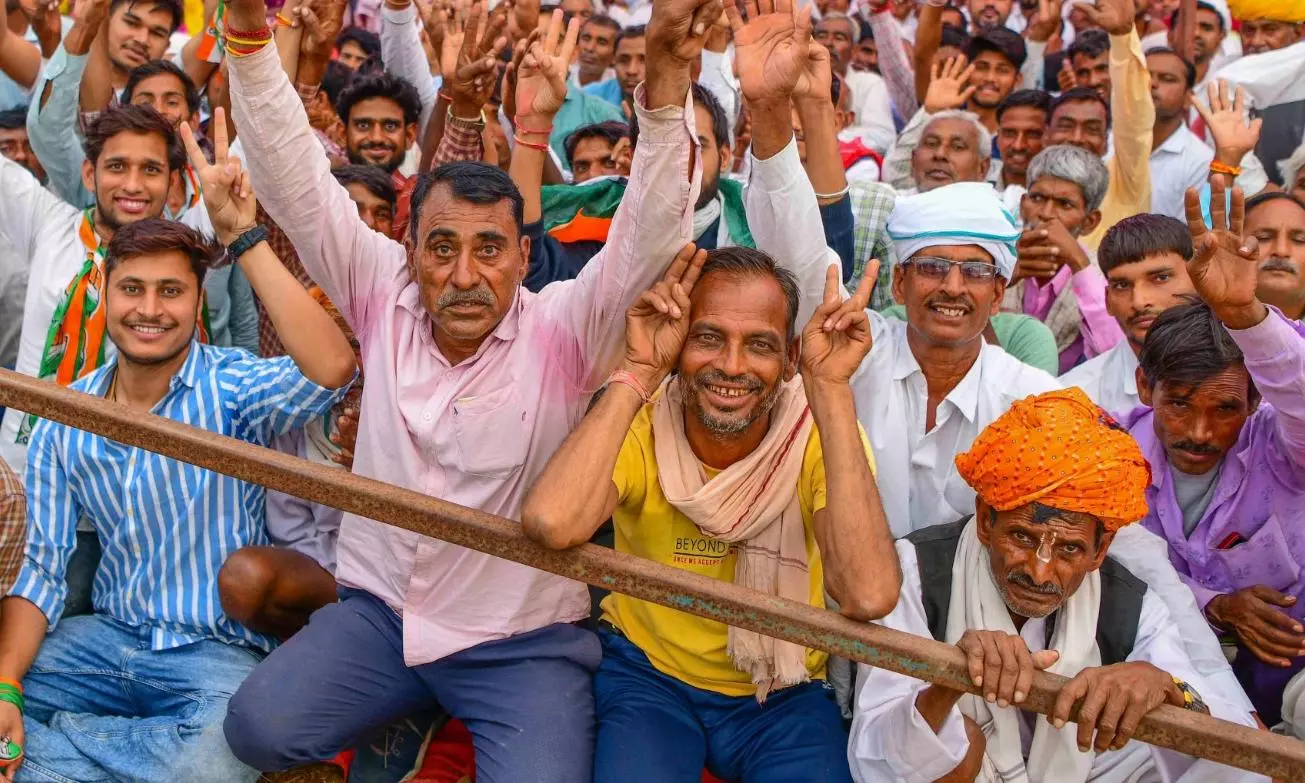
- Home
- India
- World
- Premium
- THE FEDERAL SPECIAL
- Analysis
- States
- Perspective
- Videos
- Sports
- Education
- Entertainment
- Elections
- Features
- Health
- Business
- Series
- In memoriam: Sheikh Mujibur Rahman
- Bishnoi's Men
- NEET TANGLE
- Economy Series
- Earth Day
- Kashmir’s Frozen Turbulence
- India@75
- The legend of Ramjanmabhoomi
- Liberalisation@30
- How to tame a dragon
- Celebrating biodiversity
- Farm Matters
- 50 days of solitude
- Bringing Migrants Home
- Budget 2020
- Jharkhand Votes
- The Federal Investigates
- The Federal Impact
- Vanishing Sand
- Gandhi @ 150
- Andhra Today
- Field report
- Operation Gulmarg
- Pandemic @1 Mn in India
- The Federal Year-End
- The Zero Year
- Science
- Brand studio
- Newsletter
- Elections 2024
- Events
- Home
- IndiaIndia
- World
- Analysis
- StatesStates
- PerspectivePerspective
- VideosVideos
- Sports
- Education
- Entertainment
- ElectionsElections
- Features
- Health
- BusinessBusiness
- Premium
- Loading...
Premium - Events

SP and other alliance partners are yet to establish their presence in Madhya Pradesh and Rajasthan for Congress to seriously explore tie-ups with them
Leaders of the Bharatiya Janata Party (BJP) have publicised the fact that in a fairly large number of constituencies in the states where Assembly elections are underway, various parties comprising the INDIA alliance are contesting against one another. This is presented as proof that the anti-BJP front has come unstuck, much before the formation has cemented for the Lok Sabha elections in 2024.
The facts are as follows: The Congress party, now considered a doughty challenger to the incumbent BJP in Madhya Pradesh, faces INDIA allies in as many as 92 of the 230 assembly seats, which is a high 40 per cent.
Of these, the party will face not just one but two partners of the nascent nationwide alliance – the Samajwadi Party (SP) and Aam Aadmi Party (AAP) – in 26 or more than 28 per cent of these seats.
In three other seats, the party will also face candidates put up by the Janata Dal (U). Besides this, the Mayawati-led Bahujan Samaj Party (BSP) has forged an alliance with the sub-regional Gondwana Gantantra Party and announced that the duo would contest all 230 seats.
The BJP is now in power in the state after wresting it in March 2020 from the Congress when the Kamal Nath government was pulled down. Due to the none-too-impressive track record of the state administration, the polls are being held amid a visible anti-incumbent sentiment.
Allies as foes?
Common sense will guide us into believing that division in the votes against the ruling party is likely to damage the prospects of the Congress in staging a comeback. A similar situation, though not matching in extent, prevails in Rajasthan too where the Congress is the incumbent. In addition, the state has a tradition since 1993 of not electing the same party twice in succession.
In Rajasthan, the BSP has already announced close to 50 candidates while the AAP too has fielded a similar number. The precise number of candidates from these two parties will be clear after the last date for withdrawals, November 9.
The BSP has so far not figured in the INDIA talks and it is unlikely that it will become a member of the conglomeration. The Congress could have entered into a pact with the party irrespective of this but has chosen not to.
However, the AAP and JD(U) are among the core members of the INDIA grouping. So, the question is simple: will the contests in MP and Rajasthan lead to bad blood between these parties and take the shape of a hurdle when seat distribution is being negotiated for the Lok Sabha elections?
Before straightaway confronting this question, it is prudent to revisit results of the past few elections in the two states. This will provide a sense of the likely impact of the presence of INDIA alliance partners on the prospects of the Congress.
Madhya Pradesh deadlock
In MP, the SP fielded candidates, either in its present version or in its previous avatar, the Janata Dal, since 1990 when the Congress hegemony ended and elections began being contested more keenly. But significantly, the JD had roots in the state’s socialist parties, partnered the BJP in that election. However, this pact was not perfect and their candidates contested against one another in several seats, in what was till the turn of the century, the united MP.
Political divergences between the Congress and the socialists and later the JD and its offshoots, like the SP, have always remained and this has been the primary reason for the Congress and SP not forging a pact during state polls even after the first elections were held after the undivided state was divided and Chhattisgarh carved out.
The SP fielded a fairly large number of candidates in the post-division elections: 2003 (161), 2008 (187) and 2013 (164). It significantly reduced the number of its candidates to 52 in the previous polls in 2018. The SP won seven assembly constituencies in 2003 but this tally fell to one in 2008, none in 2013 and against just one in 2018. This is also the period when the state has witnessed greater polarization between the BJP and its principal opponent, the Congress.
Barring in the odd seat, the presence of other parties, either its INDIA partners, or the BSP, the prospects of the Congress are unlikely to be affected widely in MP with their electoral presence. The overall trend and electoral narrative of the polls is not expected to alter because the presence of the SP and BSP is sub-regional in character.
Rajasthan scenario
It is not going to be dramatically different from the past in Rajasthan too, which has a long tradition, at least 1998, of independent candidates and BSP winning five to 10 percent of the total 200 Assembly seats in the state. The break up may not be a definite indicator but is certainly a pointer: 1998 – BSP (2) and Independents (7), 2003 – BSP (6) and Independents (14), 2013 – BSP (3) and Independents (7), and 2018 – BSP (6) and Independents (13).
It is amply evident that the SP and other INDIA partners are yet to establish their presence in MP and the BSP in Rajasthan for the Congress to seriously explore electoral alliance with these parties. The stakes for the Congress, however, are significantly high because its performance in the three states where it is locked in a virtual one-on-one contest with the BJP must necessarily be impressive.
Only then will the grand old party be in pole position when the INDIA alliance is formalised and the parties get into seats adjustment. A credible performance of the Congress in these polls, winning at least two of the three northern states, if not all, and a firm signal of being on the comeback trail in Telangana will not only demoralize the BJP cadre and leadership but also increase its heft with the opposition grouping.
Significantly, the INDIA alliance partners have been realistic in their approach and made it discreetly known that they are not aiming to forge strategic alliance in every state. This is particularly true for a state like Punjab which although electing just 13 Lok Sabha members will witness an all-out contest between the AAP and the Congress mainly because the BJP is not a significant force and its alliance with the Akali Dal is unlikely to be resurrected.
What is happening in Uttar Pradesh
Uttar Pradesh will once again be a crucial state and an aggregation of Opposition parties there will be essential to limit the BJP’s tally from the state below than what it was in 2019 – 62 on its own plus two won by its ally, the Apna Dal (Sonelal).
While several Opposition parties have crowded up the electoral scenario in MP and Rajasthan and has provided fodder to the BJP to undermine its principal adversary, real equations will be drawn up after December 3 when the results of this round are declared.
(The writer’s latest book is The Demolition and the Verdict: Ayodhya and the Project to Reconfigure India. His other books include The RSS: Icons of the Indian Right and Narendra Modi: The Man, The Times. He tweets at @NilanjanUdwin.)
(The Federal seeks to present views and opinions from all sides of the spectrum. The information, ideas or opinions in the articles are of the author and do not necessarily reflect the views of The Federal.)


